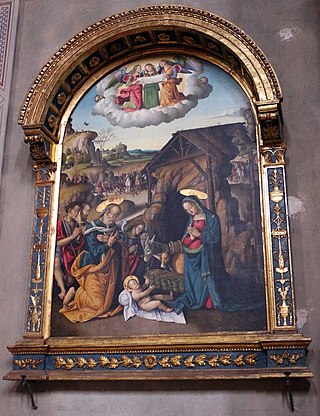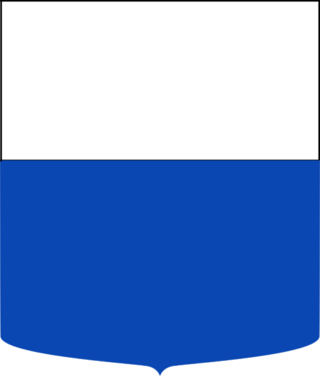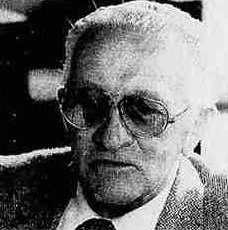
Melchiorre Cesarotti was an Italian poet, translator and theorist.

Marco Girolamo Vida or Marcus Hieronymus Vida was an Italian humanist, bishop and poet.

Giambattista Pittoni or Giovanni Battista Pittoni was a Venetian painter of the late Baroque or Rococo period. He was among the founders of the Academy of Fine Arts of Venice, of which in 1758 he became the second president, succeeding Tiepolo.

Prato della Valle is a 90,000-square-meter elliptical square in Padova, Italy. It is the largest square in Italy, and one of the largest in Europe. Today, the square is a large space with a green island at the center, l'Isola Memmia, surrounded by a small canal bordered by two rings of statues.

Enrico Scrovegni was a Paduan money-lender who lived around the time of Giotto and Dante. He was the son of Reginaldo degli Scrovegni and Capellina Malacapelli, and was married twice, first to a member of the Carrara family, then to Jacopina (Giacomina) d'Este, daughter of Francesco d'Este, Marquis of Ferrara. He may have been a member of the Cavalieri Gaudenti.

Luigi De Giudici was an Italian painter of the Venetian anti-academic movement in the first years of the twentieth century. His works were exhibited at Ca' Pesaro between 1912 and 1920 and at the International Exposition of Paris (1937).
Giuliano Pisani is a writer, classical philologist, scholar of ancient Greek and Latin literature, and art historian who was born on April 13, 1950 in Verona, Italy. He graduated with a degree in ancient Greek history from Padua University with Professor Franco Sartori. He was a full professor of Greek and Latin literature at Liceo Tito Livio in Padua. Since 2011, he has been a member of the National Italian Committee of the Promoters of Classical Culture at MIUR. He was also the technical coordinator of the first Olympiad in Classical Languages and Civilizations, which was held in Venice.

Nicholas Leonicus Thomaeus was a Venetian scholar and professor of philosophy as well as of Greek and Latin at the University of Padua.

Guido Alberto Fano was an Italian pianist and composer. From 1894 he was the favoured pupil of Giuseppe Martucci. From 1922 he was professor of piano at the Milan Conservatory. In 1938 he was removed from this position because of the Italian Fascist racial laws and from 1943 to 1945 was in hiding at Fossombrone and Assisi. He returned to teaching 1945–47, then retired.
Sergio Zanni is an Italian painter and sculptor. After obtaining the Diploma at the Institute of Arts 'Dosso Dossi' in Ferrara, Italy, he graduated from the Academy of Arts in Bologna. He taught in the Institute of Arts 'Dosso Dossi' until 1995. For his research in sculpturing he utilized backed clay and, successively, lighter material for sculptures of large dimensions.

Gaetano Cozzi was an Italian historian, professor at Padua University, and researcher with the Giorgio Cini Foundation and Fondazione Benetton Studi e Ricerche. He was a specialist in Venetian history, with special attention to the institutions, the relationship between law and society and the cultural environment.

Paolo De Poli was an Italian enameller and painter.
If we can speak of an Italian art of enamel, it is thanks to De Poli, to the road he opened up and followed faithfully, to the example of his orthodox technique, to his sureness of touch, to the esteem and admiration he has won. And we should to be grateful to him for this also. Gio Ponti

Juti Ravenna was an Italian painter.

Giuliano Presutti or Persciutti or Presciutti (active, Fano, 1490 – Ancona, 1557 was an Italian painter of the Renaissance period, active in Marche and Umbria.

Gianmaria Potenza is an Italian artist born in Venice living and working in Venice, Italy.
Gian Piero Brunetta is an Italian film critic, film historian, and academic.
Dino Formaggio was an Italian philosopher, art critic, and academic. He is part of the Italian phenomenological school or the School of Milan and is noted for his development of an organic description of the experiential complexity where art is phenomenologically constituted.

CavaliereGirolamo Zulian was a Venetian nobleman, ambassador, patron of the arts, art collector and Senatore Amplissimo. A member of the House of Zulian, he is best known for his leading art collection and for being one of the earliest patrons of Canova, a great friend of his, from whom he commissioned the Theseus and the Minotaur in 1781, while serving as ambassador to Rome. Zulian is credited as having played a fundamental role in Canova's rise to fame.

Massimo Mila was an Italian musicologist, music critic, intellectual and anti-fascist.
Michele Sambin is an Italian theatre director and artist.














